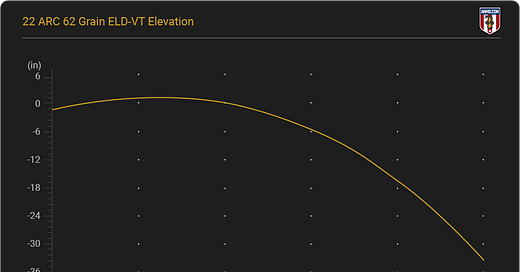22 ARC Ballistics Tables From Every Major 22 ARC Ammunition Maker
We’ve gathered 22 ARC ballistics tables from every ammunition manufacturer that makes 22 ARC ammo. Find out which round works best in your rifle.
Welcome to our comprehensive .22 ARC Ballistics Guide! The .22 ARC (Advanced Rifle Cartridge) is gaining popularity among shooting enthusiasts for its exceptional performance and versatility. Understanding the ballistics of the .22 ARC is crucial to maximizing its potential.
In this guide, we will delve into the specifics of the .22 ARC cartridge, exploring its origins, design, and performance characteristics. We'll cover key aspects such as velocity, energy, trajectory, and accuracy, providing you with detailed data and analysis to enhance your shooting experience.
22 ARC Trajectory Chart
A bullet’s flight path is its trajectory. Shooters often measure the bullet’s elevation in inches of bullet drop, but it’s also measured in minutes of angle (MOA).
A flat trajectory is preferred because the shooter can make fewer adjustments to compensate for bullet drop. The 6.5 Creedmoor and 308 Winchester are excellent examples of flat-trajectory rifle cartridges, so they’re prevalent among long-range shooting enthusiasts.
The 22 Advanced Rifle Cartridge can be added to the list of flat trajectory rounds, as it drops about 33”-42” at 500 yards (200-yard zero; 24” barrel; depending on projectile). The 62 grain ELD-VT bullet is an excellent choice for varmint hunting because of its flat trajectory out to 500 yards and farther. Your bolt gun or AR-15 platform rifle’s barrel length and twist rate will greatly affect performance, but you can expect about -33.5” drop at 500 yards (200 yard zero; 24” barrel).
This is thanks to the high BC bullets commonly loaded in 22 ARC ammo. The long, sleek projectiles slice through the air with low drag and are less affected by wind drift, which allows shooters to be incredibly accurate at longer ranges.
22 ARC Velocity
A bullet’s muzzle velocity is the rate at which it exits the rifle barrel, measured in feet per second (fps).
A longer barrel generally produces a higher muzzle velocity, as it gives the exploding propellant more time to exert energy against the bullet’s base. Bullet design and weight also significantly affect how much velocity a projectile will exhibit downrange.
For example, heavier bullets have higher inertia and relatively lower muzzle velocities. The Hornady 22 ARC 75 grain ELD Match bullet has a muzzle velocity of 3,075 fps, whereas the 88 grain ELD Match bullet has a muzzle velocity of 2,820 fps.
Polymer-tipped hollow point boat tail bullets, which are used in the new cartridge designs by Hornady, tend to conserve velocity more efficiently than traditional soft point bullets. They’re more ballistically efficient!
Hornady claims the muzzle velocity of the 22 ARC cartridge ranges from 2,820 fps to 3,300 fps, which is excellent for a varmint bullet. Handloads tend to have higher velocities than factory-loaded ammo, which is one reason why reloading is so popular among dedicated shooting enthusiasts and competitive shooters.
22 ARC Kinetic Energy
A bullet’s energy is measured in foot-pounds (ft-lbs). Muzzle energy reflects the force with which a projectile leaves the barrel. Heavier bullets tend to have higher muzzle energy. Velocity is also a significant factor, so it’s important to remember that lighter bullets can have greater muzzle energy than heavier ones.
A higher muzzle energy typically means the round has more recoil. The 22 ARC’s lightweight projectiles generate little recoil energy. It is an excellent cartridge for introducing someone to the shooting experience from a gas gun like the AR platform or a bolt-action rifle.
The biggest problem with lightweight projectiles is that they conserve relatively less energy downrange. For instance, the 62 grain ELD-VT has 1,499 ft-lbs of energy at the muzzle but only 636 ft-lbs at 500 yards. On the other hand, the 88 grain ELD has 1,554 ft-lbs at the muzzle and 813 ft-lbs at 500 yards.
22 ARC Effective Range
Due to its lightweight projectiles, the 22 ARC’s effective range is about 500 yards for varmint hunting.
You can stretch that to 750 yards while shooting a target. Experienced long-range shooters can hit targets 1,000 yards away with some practice.
How Do 22 ARC Ballistics Compare to Similar Rifle Cartridges?
While the 22-250 Remington ruled American varmint hunting for years, many are switching to the 22 ARC because of its superior performance in the same conditions and heavier projectiles.
This begs the question: What other cartridges could be obsoleted by Hornady’s 22 ARC? Is the 223 Remington, 224 Valkyrie, 22-250 Remington, 22 Nosler, 22 Creedmoor, or 6.5 Grendel safe from the 22 ARC?
The team at Ammo.com has gathered a few ballistics charts to help you compare these similar rifle cartridges.
Continue reading about 22 ARC ballistics here.




